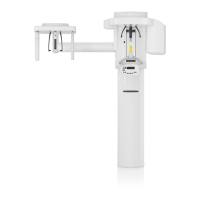Dentsply Sirona
Operating Instructions Orthophos E
2 Safety instructions
2.18 Electrostatic discharge
67 11 001 D3352
D3352.201.12.01.0203.2019
15
2.18
Electrostatic discharge
Protective measures
ESD stands for
E
lectro
S
tatic
D
ischarge.
Electrostatic discharge from people can damage electronic components
when the components are touched. Damaged components usually have
to be replaced. Repairs must be performed by qualified personnel.
Measures to protect against ESD include:
● Procedures to avoid electrostatic charging via
– air conditioning
– air humidification
– conductive floor coverings
– non-synthetic clothing
● discharging the electrostatic charges from your own body through
contact with
– a metallic unit casing
– a larger metallic object
– any other metal part grounded with the protective earth
● Wearing an antistatic band that creates a connection between the
body and a protective ground wire.
Areas at risk are indicated on the unit with the ESD warning label:
We recommend that all persons working with this system are made
aware of the significance of the ESD warning label. A training course
should also be held to inform users about the physics of electrostatic
charges.
Physics of electrostatic charges
An electrostatic discharge requires prior electrostatic charging.
There is a danger of electrostatic charges building up whenever two
bodies rub against each other, e.g. when:
● walking (soles of shoes against the floor) or
● moving (chair casters against floor).
The amount of charge depends on several factors. The charge is:
● higher at low air humidity than at high air humidity, and
● higher with synthetic materials than with natural materials (clothing,
floor coverings).
The following rule of thumb can be applied to assess the transient
voltages resulting from an electrostatic discharge.
An electrostatic discharge is:
● perceptible at 3,000 V or higher
● audible at 5,000 V or higher (cracking, crackling)
● visible at 10,000 V or higher (arc-over)

